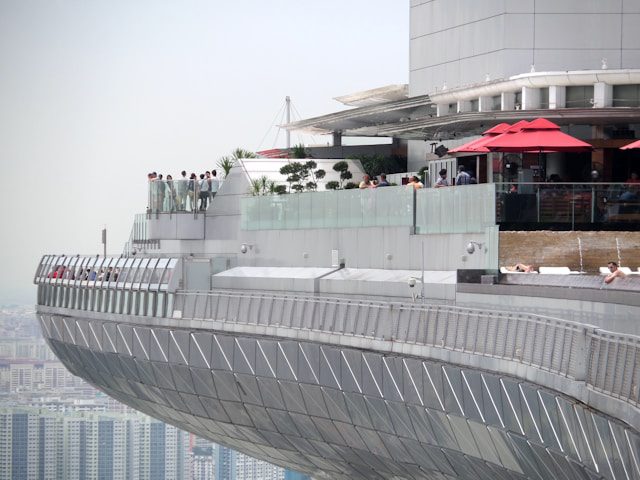Sometimes, the best hotels are characterized and famous for more than their rooms, services, or free parking. For many of the finest and most famous, their status comes not so much from their function as a hotel as their tale. Indeed, you’ll discover that the hotels known extensively by many tend to have rich and top historic luxury hotel experiences.
For many, that’s part of the fun of staying there, to become part of the evolving narrative behind the building and remain in the same rooms as succeeding generations of great and low guests. The following hotels have been picked because they’re historically noteworthy, some being inducted into Historic Hotels of America, and preserve some timeless classical charm in their architecture and presentation. Make your own part of history the next time you plan a holiday.
The best moment of every hotel experience comes immediately after check-in, after the journey in the ornate elevator, after the handing over of pleasingly heavy-set keys, and just after the bell-hop has led your bags up to your room. It’s that moment when you close the door behind you and stand alone in your suite for the first time.
Jump on the bed, hark at the vista, slip your shoes off amid the luxurious carpet, boggle at the steep-sided bath, and ogle the local lager in the secret minibar. The world’s finest hotels manage a unique trick – they transport you fully while always making you feel at home.
There are a few top historic luxury hotel experiences that are necessary before your time is up. Staying at one of the world’s historic hotels is among them, with many being celebrated by the National Trust for Historic Preservation. They become doorways to entire destinations and form unforgettable memories.
Historic hotels provide a different kind of holiday. From time-shrouded taverns to fairytale castles, each has its fascinating past just waiting to be unearthed. Some lived earlier lives in the mansions of historic aristocratic families.
Others evolved in the 19th century when long leisurely journeys became a distinguishing standard among Europe’s wealthier upper classes. Still others are so long-lived that their recorded existence slips deep into the dark ages, and now are recognized by the National Trust for Historic Preservation. The only thing they have in common is that each of these great old lodgings has its historical tale and unique top historic luxury hotel experiences.
Best Historic Hotel and Resort to Get Top Historic Luxury Hotel Experiences
1. Claridge’s Lindon, England
Claridge’s has cemented its image as London’s most fashionable and best-loved hotel, becoming a byword for outstanding service, magnificent hospitality, and old-world elegance, contributing to its status as a member of historic hotels. From the moment you stroll through the rotating entrance into the stunning art deco-tiled floor, you are engulfed in an air of timeless grandeur.
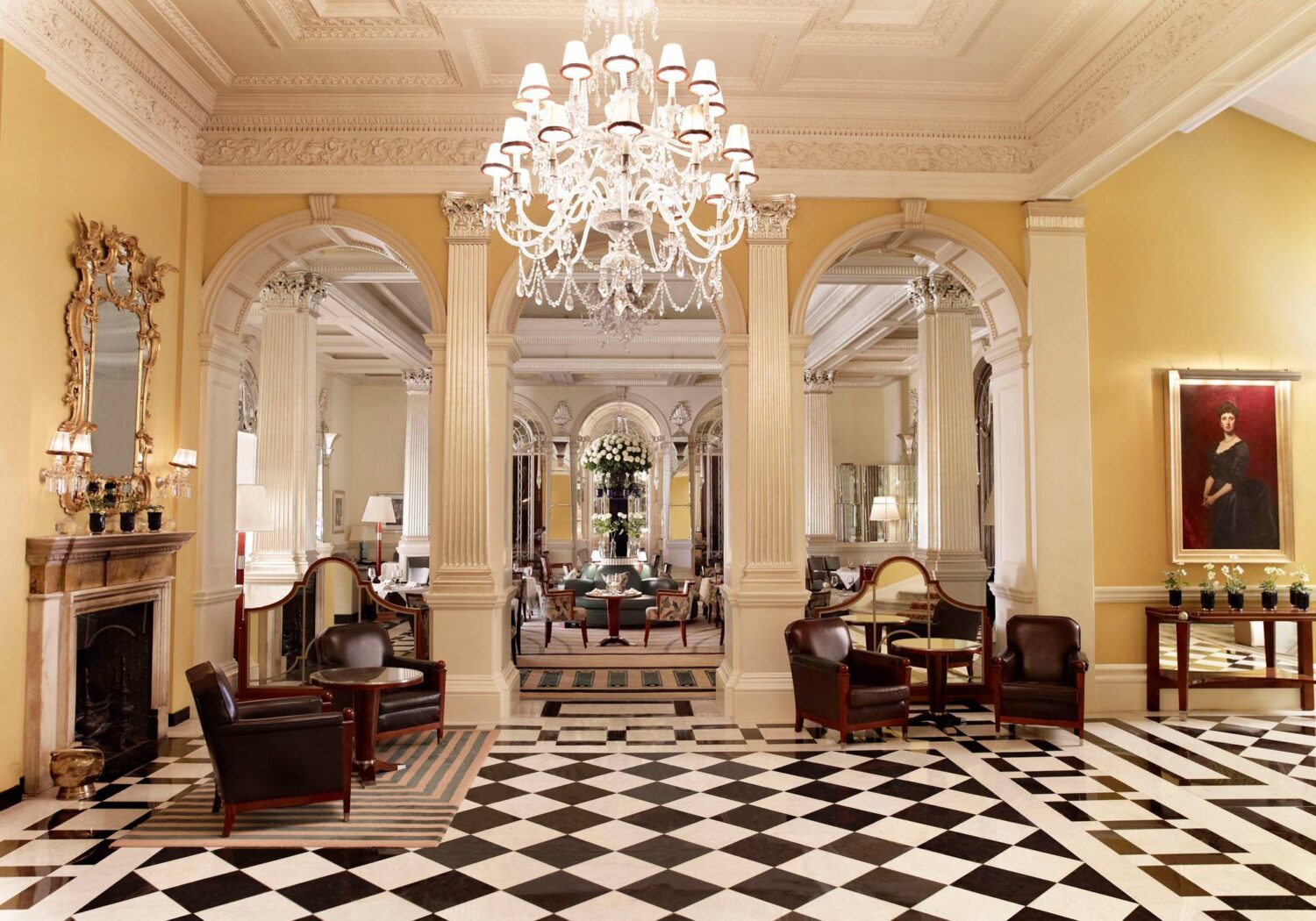
The sumptuous decor merges rich historical aspects like the spectacular carved staircase with modern facilities and exceptional personal service. Claridge’s central Mayfair location is the perfect pied-a-terre for exploring London’s world-class dining, shopping and cultural attractions.
Yet the hotel is a destination, with the exquisite Michelin-starred Fera restaurant, the bustling Fumoir bar, and the famed afternoon tea service. Claridge’s has the air of a private club where you’re instantly made to feel at home – it’s no wonder this is where so many smart jetsetters make their London base.
Claridge’s Hotel Heritage, Awards of Excellence and Special Guests
Bought in 1854 by Mr and Mrs William Claridge, the hotel earned the final sign of approval in 1860 when Queen Victoria visited her friend, Empress Eugénie of France, who was using Claridge’s as her winter quarters.
So began a history of royal visits that continues to this day – Prince William and Kate Middleton were spotted enjoying a special supper there just this May.
In 1893, Claridge’s was bought by Richard D’Oyly Carte, proprietor of the Savoy hotel, who commissioned the designer of Harrods, CW Stephens, to demolish the original buildings and rebuild the exquisite seven-storey hotel that exists today. The new Claridge’s, a hotel also known for its historic significance, opened for operation in 1898.
Since then, its exquisite apartments and rooms have been a source of witness to many historic occurrences. While the Second World War raged in Europe, many exiled kings and queens, including the King of Norway and the Queen of the Netherlands, found a haven in Claridge’s – so many that when a diplomat telephoned the hotel in 1947 and asked to speak to the King, the response was “Certainly sir, but which one?”
On 17 July 1945, Claridge’s room 212 formally became part of Yugoslavia for the day. In an unconventional gesture of British courtesy, the prime minister at the time, Winston Churchill, made the concession because it was the only way for Crown Prince Alexander, heir to the throne, to be born on Yugoslav soil—according to legend, Claridge’s staff placed a clod of Yugoslav earth under the queen’s bed during her labour.
But it’s not only royalty. The hotel’s guestbook reads like a movie bill poster from the golden years of Hollywood. During the 1950s, screen icons Grace Kelly, Audrey Hepburn, Cary Grant, and Bing Crosby all strolled past the Claridge’s lobby—although Katharine Hepburn had to use the staff door. She was excluded from the lobby for wearing trousers, which was still highly uncommon for ladies at the time.
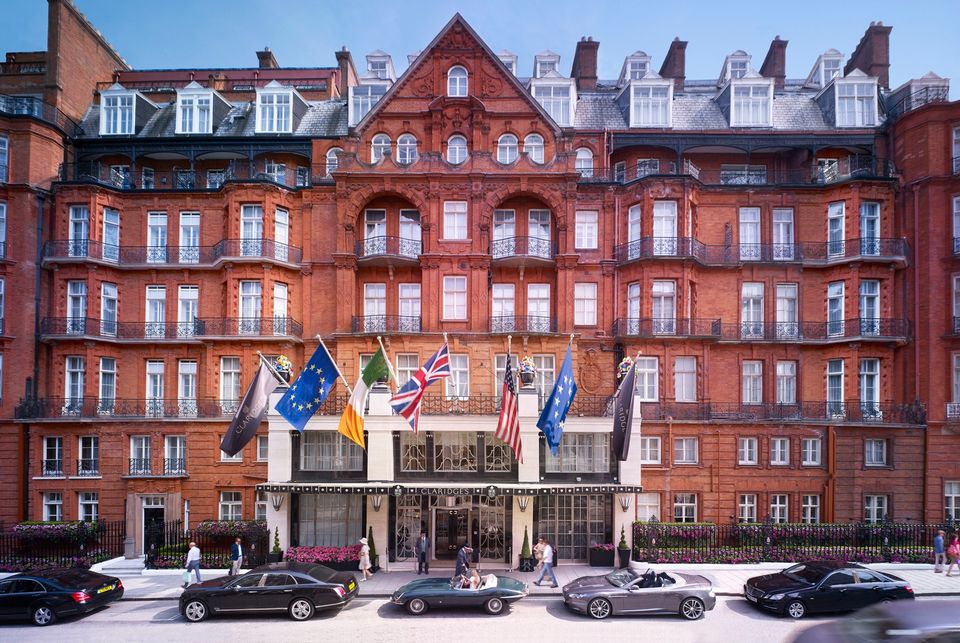
In 1956, the then premier of the Soviet Union, Bulganin, and the first secretary of the Communist Party of the Soviet Union, Khrushchev, made Claridge’s headquarters during their controversial stay in London. They held a party in the Royal Suite that is said to have gotten so crowded that ‘buttons popped off jackets’.
Its prominence as a high-end party venue continues to this day – the Claridge’s penthouse is where Kate Moss opted to celebrate her 30th birthday, and A-listers from Victoria Beckham to Madonna and Gwyneth Paltrow have attended festivities held within its walls.
Equally dazzling as the guests, the structure itself has much to say about British history. Its unique architectural and design eccentricities tell the tale of 1920s London – the grandeur and dramatic design of the interior can be regarded as a response to the years of austerity of the First World War, showing a yearning for excitement and the new-found riches of the period.
While many of the original 19th-century characteristics are maintained today, Claridge’s, a historic hotel also celebrated for its Art Deco renovation, received its most dramatic renovation during the Art Deco period. This was the time when Claridge’s added its ballroom and carried out substantial refurbishment on its restaurant, entrance, and several rooms, all in a style dubbed ‘Regency Vogue’.
Over the years, redesign and refurbishment continued, culminating in Thierry Despont – a New York interior designer known for his work on the centennial restoration of the Statue of Liberty – being invited to restore the ground floor in 1998, creating Gordon Ramsay at Claridge’s, the intimate Fumoir, the elegant Foyer and Reading Room, with the 19th century and art deco details being enhanced by the Dale Chihuly light sculpture which graces the heart of the hotel.
2. Le Sirenuse Hotel, Positano
The hotel is handled with a winning mix of charm and Swiss-trained efficiency by Antonio Sersale and his wife Carla with outstanding attention to detail. Facilities abound; a fantastic Aveda spa created by Gae Aulenti, a pool deck with sun loungers and lemon trees in big pots, one of the most romantic restaurants in the world and multiple bars.
From its elevated cliffside perch just outside the pedestrian-only core of Positano, the Sirenuse commands excellent views over the tumble of village cottages, the brilliant maiolica dome of Santa Maria Assunta and the coastline. A five-minute walk down the tiny, tourist-clogged alleyways gets you to Marina Grande with its stacks of loungers and umbrellas and crowded quayside where you can hop on a ferry for Capri, Sorrento and Amalfi.

The renowned Sirenuse is one of the Med’s great hotels – sleek, smart and pricey yet having the air of a private house, although a very privileged one. Exceptional facilities go hand-in-hand with exceptional service and a spectacular cliffside setting a short sashay from the town of Positano.
Le Sirenuse Hotel’s Heritage and Special Guests
American writer John Steinbeck visited the Amalfi coast in 1953 and perfectly captured its allure, writing, “Positano bites deep. It is a dream place that isn’t quite real when you are there and becomes beckoningly real after you have gone.” At the heart of this dreamy coastal village sits the legendary Le Sirenuse, a family-owned gem celebrating its 70th anniversary in 2021.
Its arched balconies, white terracotta walls, and growing bougainvillaea epitomize Mediterranean charm. Yet Le Sirenuse wonderfully defies pretension – the ambience is warm and welcoming, developed by the Sersale family, who bought the former villa as their summer home in 1951.
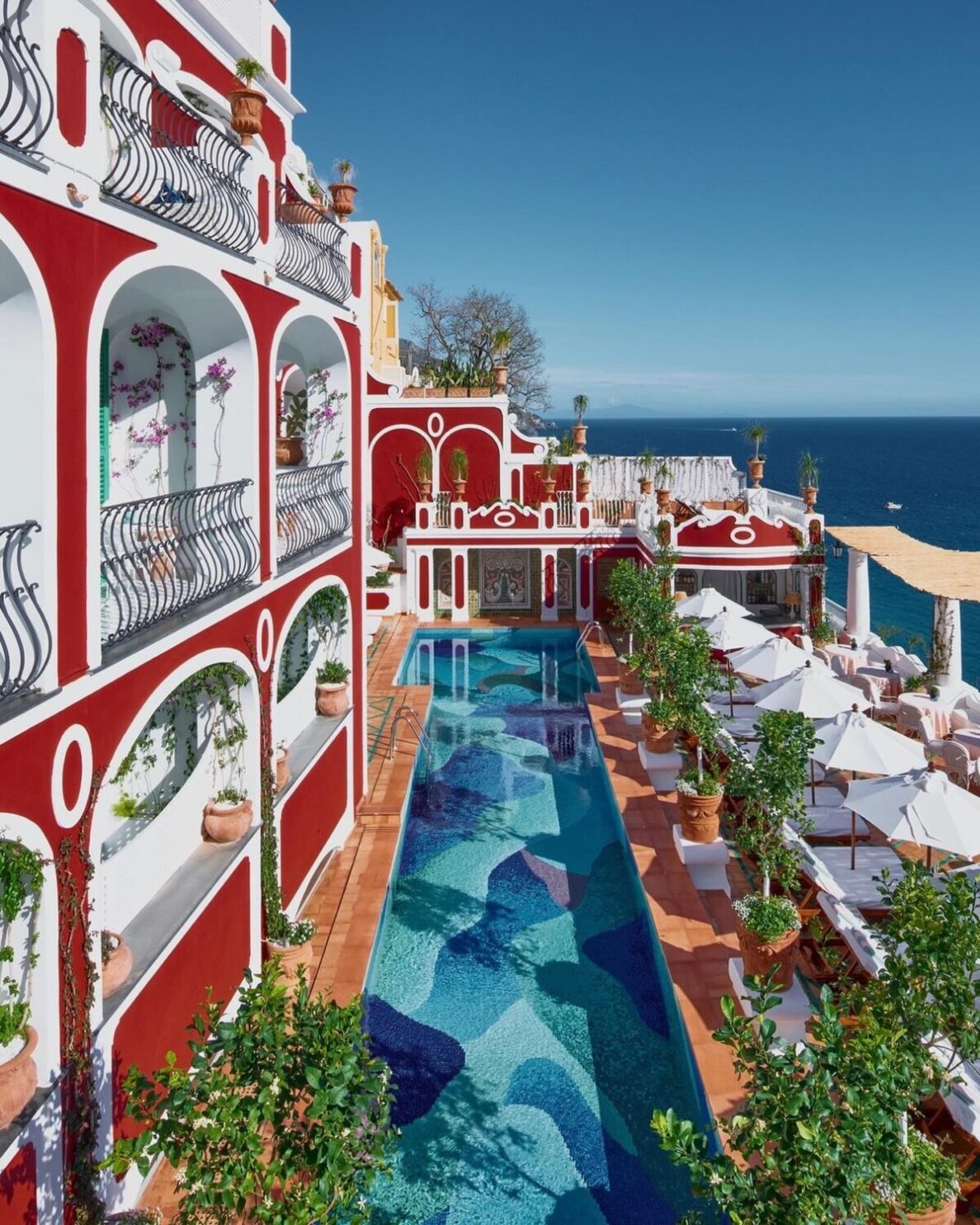
3. Villa d’Este On Lake Como
Indescribably exquisite and impossibly stately, Villa d’Este is a towering, dazzling monument to la dolce vita that seems to spring organically from the waters of Lake Como.
This 16th-century Renaissance villa-turned-luxury hotel seamlessly blends artificial splendour with natural beauty. The beautiful gardens constructed by several recognized architects are unique, with Renaissance grottos, Baroque ancient ruins, and kilometres of flowery trails. But the pièce de résistance is the floating pool.
In this ingenious design, a portion of Lake Como waters are siphoned into the pool, creating the illusion of the pool extending into the lake.
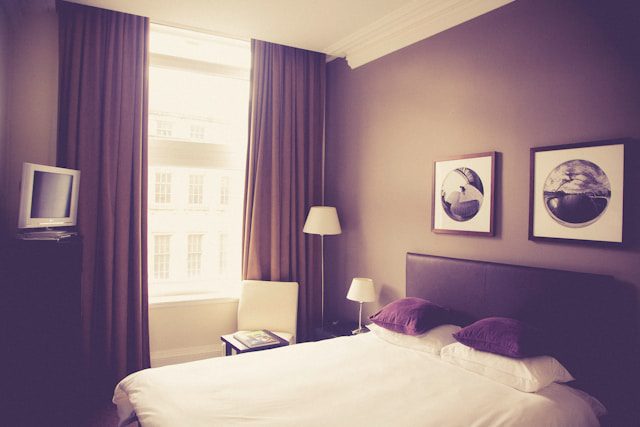
Villa d’Este Hotel’s Heritage and Special Guests
Few hotels worldwide can boast they’ve been running since Ulysses S. Grant was president, so a sesquicentennial milestone demands celebration. But when that hotel is Villa d’Este, a regular birthday celebration won’t do.
Instead, in March, the legendary resort on Italy’s Lake Como launched off a year of unique events, cuisines, programmes and more, all culminating in another uncommon occasion: The hotel will remain open until January to host Christmas and New Year’s Eve festivities. Cue a wild dash for bookings.
There have been the VIP fans, of course, from royals, heads of state and world-class athletes to celebrities from Gable and Garbo to George Clooney, who often comes over from his lakeside villa for a cold one (usually bringing notable pals, including President Barack Obama, with him).
Bruce Springsteen’s been a regular for nearly 25 years; John Legend and Chrissy Teigen were married here. But many non-boldfaced guests have likewise been checking in for generations, and often, the staff’s incredible attention to detail keeps them returning—the barman who remembers a preferred drink or the chef who knows just how to create a favourite risotto.
When fashion designer Lorenzo Riva was the creative director for Balenciaga in the 1980s, he insisted on conducting the mission’s management meetings here instead of in Paris and even arranged a few fashion presentations on the property. Villa d’Este is “elegant, hushed, soothing and reassuring,” he thought recently. “It’s also discreet. When you enter the gate, you leave the rest outside.”

4. Abadía Retuerta LeDomaine, Spain
The vineyards of the celebrated Ribera del Duero region surround the magnificent 12th-century abbey that forms the core of the property. Yet despite its historic history, Abadia Retuerta emits a uniquely modern outlook combining old and new. State-of-the-art winemaking facilities, including a gravity-fed vinification cellar, sit adjacent to the abbey’s ancient vaulted ceilings and stone walls.
Interiors skillfully blend Period antiques and furniture with crisp, contemporary design. The two Michelin-starred Refectorio restaurant shows the culinary expertise of chef Andoni Luis Aduriz within the former monks’ eating hall.
The LeDomaine Santuario spa pioneered the concept of “vinotherapy”, harnessing the strong anti-oxidants of grapes in treatments. With a world-class golf course, a beautiful infinity pool, and a breathtaking setting, Abadia Retuerta embodies Spanish wine region hospitality at its most sublime, earning its place among the first luxury hotels of the region with historic luxury accommodations.

Abadía Retuerta LeDomaine Hotel’s Heritage and Special Guests
The Abbey of Santa María de Retuerta was founded in the 12th century near the banks of the River Duero. It has watched the ages go by at the Retuerta estate, and it is one of the most notable works of Romanesque architecture in the province of Valladolid. The Abbey was created in 1146 by Sancho Ansúrez, its first abbot and a descendant of Conde Don Pedro Ansúrez, founder of Valladolid.
From its earliest origins, the Abbey has been a vibrant cultural hub, strongly supported by monarchs, pontiffs, and other influential figures. It was here that the General Chapters of the order would convene, and from the 17th century, it became the order’s General Novitiate in Spain, further cementing its cultural importance.
The many surviving sources characterise the territory around the monastery, which dates back to an ancient estate with a long grape-growing tradition. This reinforces the area’s huge tourist potential as a historic area, as it blends the cultural significance of the old structures with the charm of superb wines.
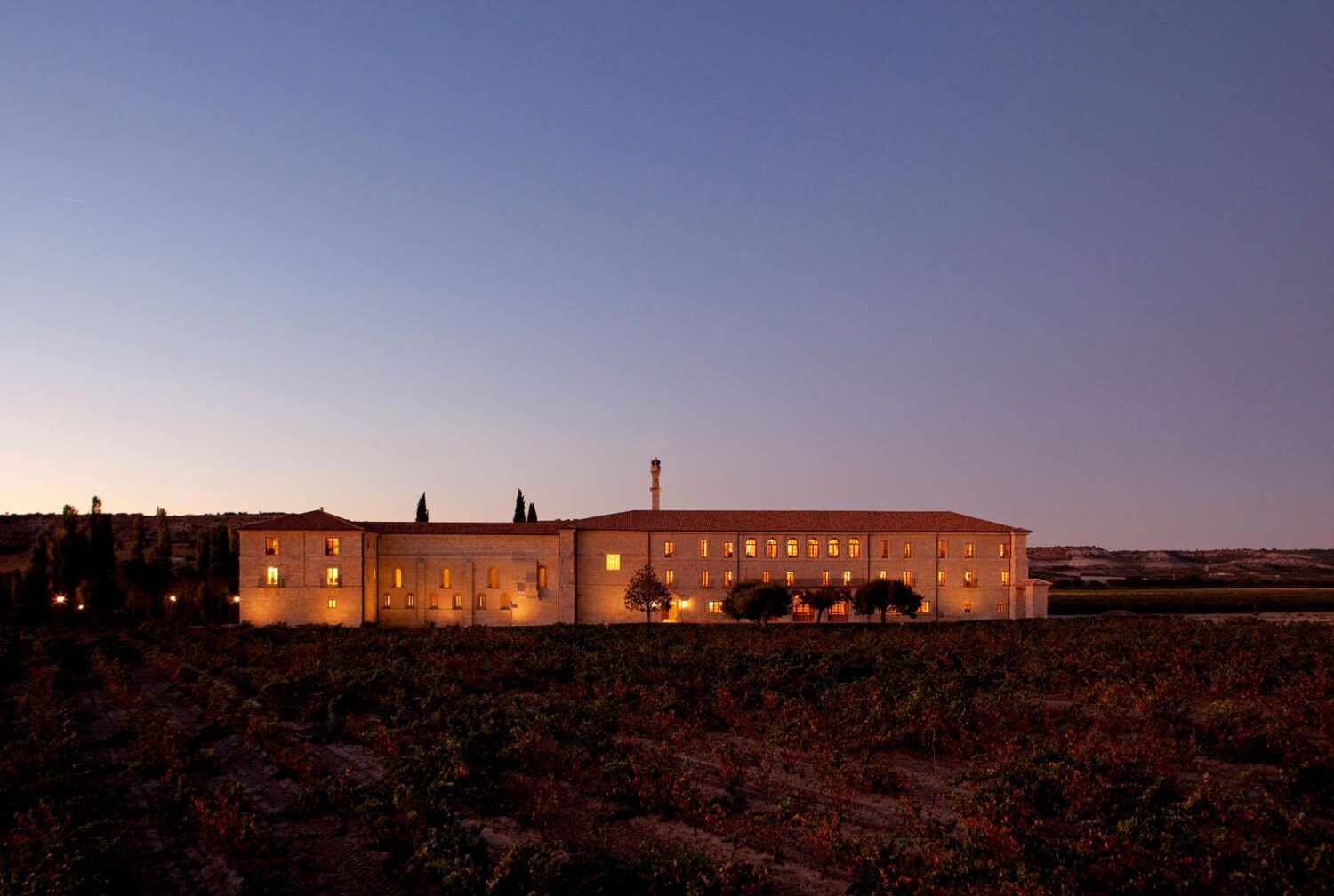
The Premonstratensian Order (within which Sancho Ansúrez was ordained as a canon) was the first to occupy Retuerta, and the Abbey was founded as the order’s headquarters in Spain.
5. The Gritti Palace Venice, Italy
A genuine grand dame, The Gritti Palace embodies the acme of Venetian splendour and artistry, having been inducted into Historic Hotels. This 15th-century palazzo enjoys one of the greatest positions on the Grand Canal, only steps from St. Mark’s Square.
You are engulfed in real Venetian splendour when you arrive via private boat transfer and traverse the elaborately sculpted marble Longhi doorway. Frescoed ceilings, ornate embellishments, and museum-quality antiques adorn the public halls and guest suites.
Yet there is an appealing warmth amid the grandeur, built over centuries of hosting global elites and showered in plaudits as one of the world’s most iconic hotels. The Gritti Epicurean School allows you to discover Venetian culinary culture directly.
The Riva Lounge is a stylish venue for traditional cocktails, and the spa’s ritual inspired by Venetian beauty traditions is a wonderfully exquisite pleasure. The Gritti is one of Venice’s most remarkable places to experience pure Italian elegance.
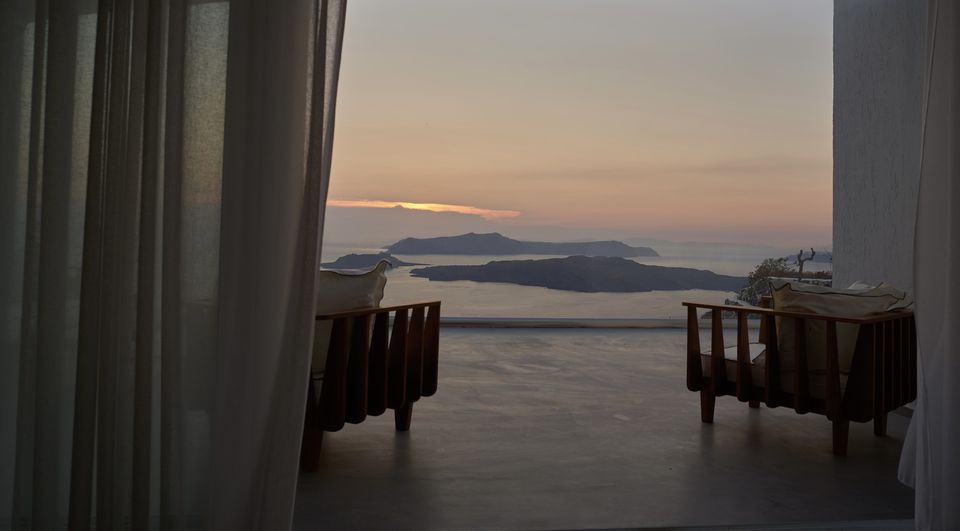
Gritti Palace Hotel’s Heritage and Special Guests
The Gritti Palace is on the Grand Canal, near San Marco. It has multiple independent buildings near each other, which you may view from the Canal as the yellow, beige, and clay facades.
The Gritti Palace, a name that echoes the rule of Doge Andrea Gritti in 16th-century Venice, stands as a testament to the city’s rich history. Originally erected in 1475, this palazzo was transformed into a hotel in 1895. A recent refurbishment has seamlessly blended the past with the present, offering modern amenities including flooding protection.
The Gritti Palace is best approached via the hotel’s boat service, which goes directly to the front of the hotel’s stairs. However, there are other water taxi services to adjacent stops that are cheaper if one prefers. The hotel features 82 rooms, a large lobby space, a terrace with cafes and restaurants overlooking the large Canal, and service to match.
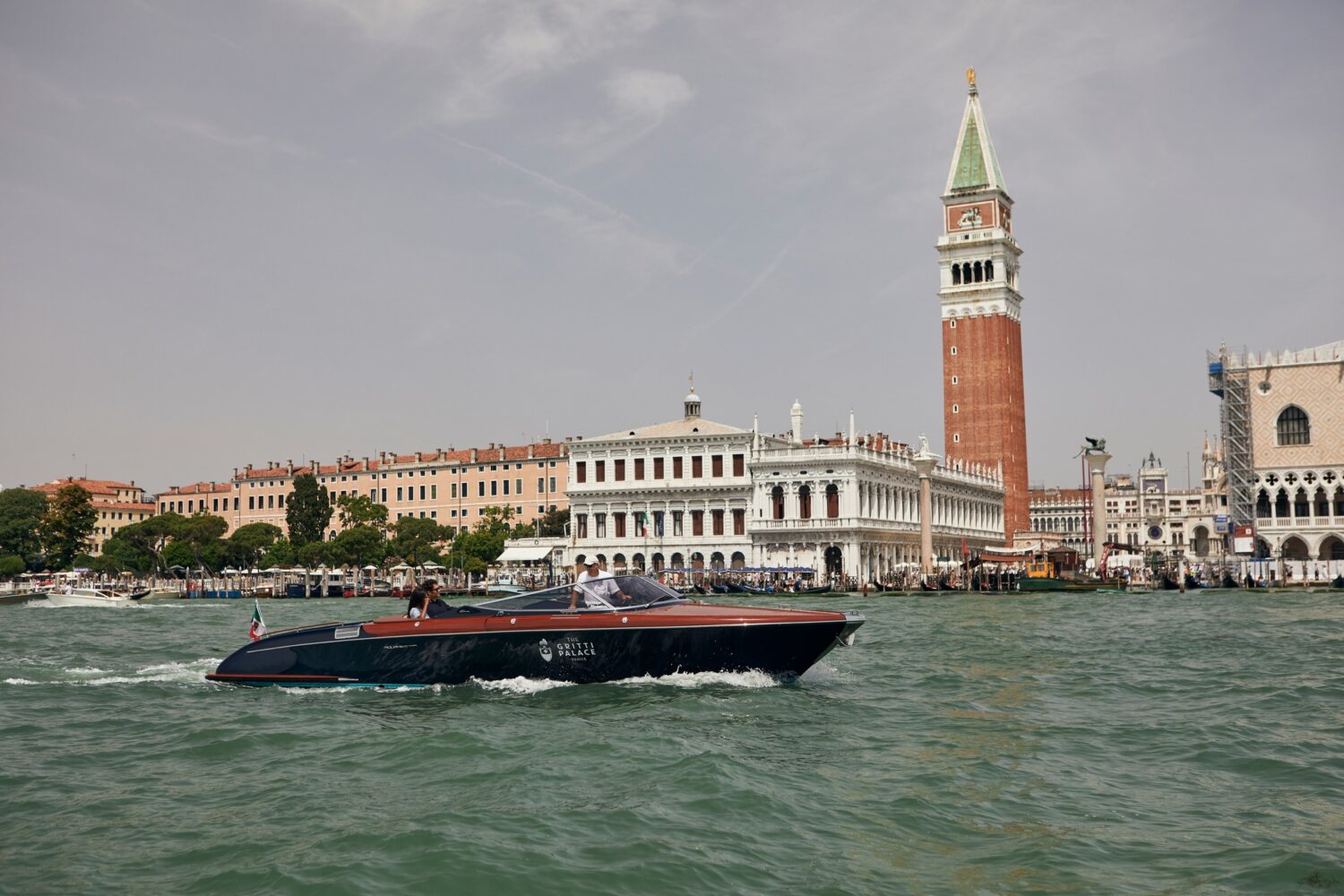
The Gritti Palace has had its fair share of legendary guests, including Ernest Hemingway, Sir Winston Churchill, Charles De Gaulle, Charlie Chaplin, Princess Grace of Monaco, and Frank Lloyd Wright—and I am not surprised, given the hotel’s magnificence.
6. Istoria Hotel – Santorini Greece
Renowned as potentially the world’s most Instagram-worthy hotel, Istoria is, first and foremost, a beautiful, enticing work of art built into the cliffs of Santorini. This refuge on the island’s calm southern shore emanates a sense of mystery and intrigue, which is hinted at by its name, “story” in Greek.
The brilliant white sculptural structures conceived by award-winning architects seem to sprout spontaneously from the volcanic caldera, flawlessly mixing artificial and natural components. An eccentric Greek widow established the all-suite enclave before taking on new life as a luxury boutique hotel—swaths of pure whitewashed stone frame tiny terraces and pools offering spectacular Aegean views. 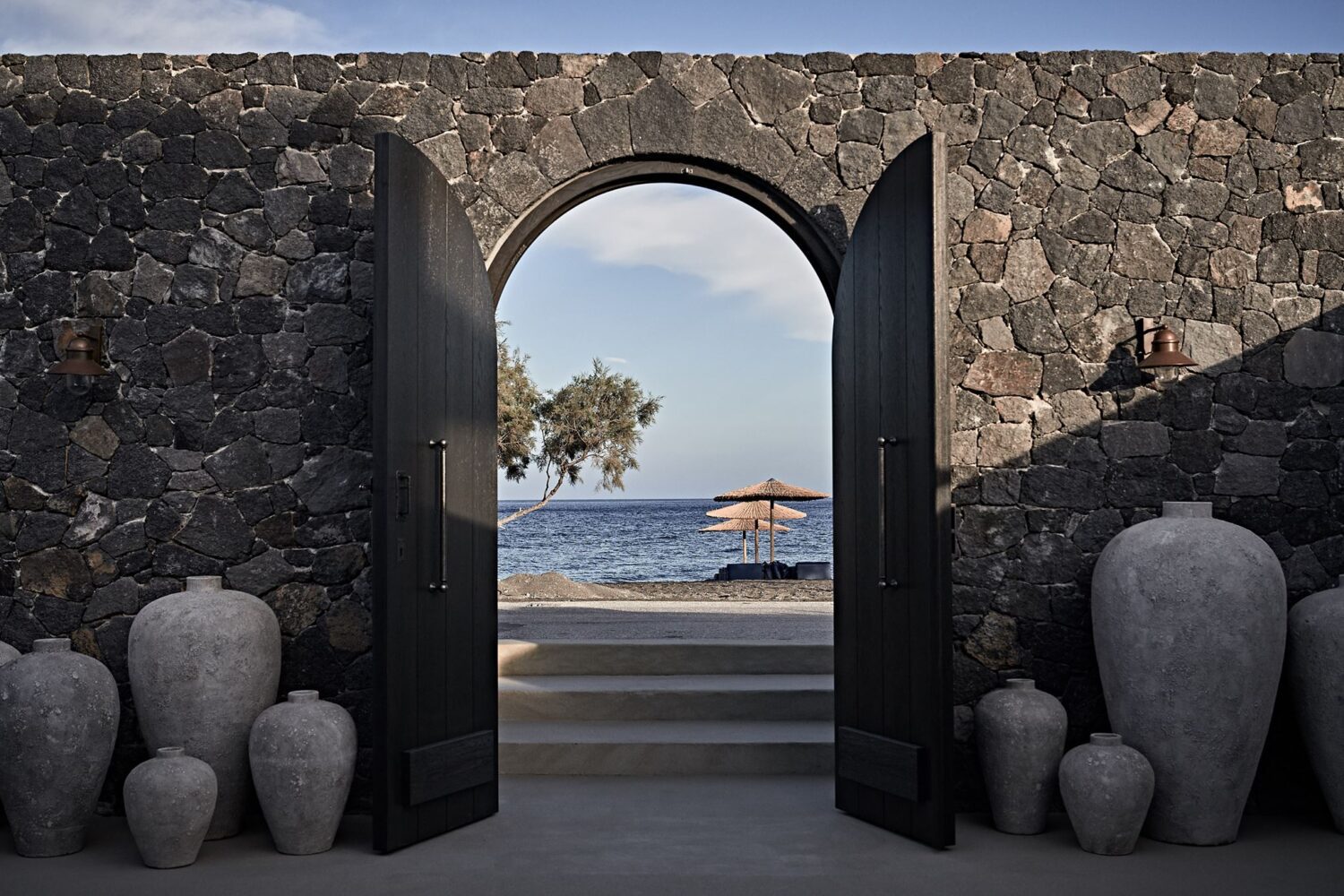
Inside the separate cave-like suites, natural materials like wood and stone form a purposefully basic yet luxurious design, allowing the panoramic vistas to take centerstage. While undeniably striking, Istoria delivers an unrivalled authentic feeling of place and farm-fresh Greek cuisine in an ambience of laid-back island grandeur.
Istoria Hotel’s Heritage and Special Guests
Named after the Ancient Greek word for story, Istoria Hotel is a beautiful design hotel launching a new chapter on Santorini’s southern coast. This lovely refuge is nestled on Perivolos Beach, far isolated from the tourists seen elsewhere on the island.
With a magnificent combination of traditional and contemporary features, this 12-suite hideaway, a proud member of historic hotels, encompasses visitors in an air of peace from the moment they arrive.
From the stripped-down style to the simple yet comfy furnishings and handcrafted linens, the elegant suites seem like an island home away from home. Designed by Athens-based firm Interior Design Laboratorium, the hotel mixes beautifully with the island’s traditional building materials of volcanic stones and coloured plaster.

7. Hotel Alfonso XIII, Seville
Named for the king who commissioned it, Hotel Alfonso XIII is a Seville landmark embodying genuine Andalusian grandeur and kindness. Framed by majestic palms and fountains, the salmon-coloured exterior hints at the vast luxury within.
Handsome courtyards with tinkling tiled fountains, lofty archways, glistening marble floors and authentic 1920s crystal chandeliers transport guests to the region’s Moorish past. Yet modern comforts and great service keep the ambience fresh and friendly rather than stuffy.
Guest rooms offer a tranquil refuge in a pleasant Mediterranean environment, many overlooking the verdant gardens or ancient city centre. The Andalusian culinary traditions emerge in dining settings, including the charming courtyard Raza Terrace, tapas haven Ena Seville, and the famed Hall of Ambassadors.

With its outstanding location steps from Seville Cathedral and the Real Alcázar, Alfonso XIII provides the perfect elegant home base for visiting this vibrant Spanish cultural centre.
Hotel Alfonso XIII Heritage and Special Guests
Hotel Alfonso XIII debuted in 1928, with a spectacular feast attended by the titular King of Spain and Queen Victoria Eugenie of Battenberg, marking its inception as one of the first luxury historic hotels. Designed by the architect José Espiau y Muñoz, the hotel was created to house dignitaries visiting the international exposition at the neighbouring ‘Plaza de Espana’.
As the structure is a historic landmark it underwent a delicate renovation. The interior and exterior are adorned in Mudejar style, inspired by Arab architecture and Seville’s rich cultural legacy, and there is a great sense of place here. Ornamented ceramic tiles (azulejos) embellish walls, ceilings and even bathrooms.
Throughout its history, Hotel Alfonso XIII has been a magnet for celebrities, monarchs and queens; today, every guest in the 151 rooms and suites gets the royal treatment from the kind and helpful personnel here.
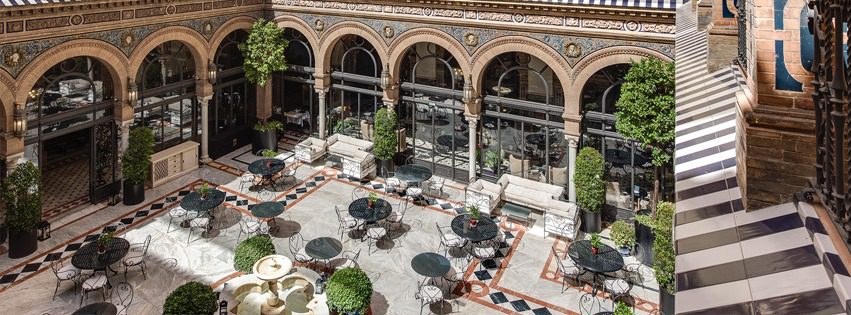
The two restaurants, the San Fernando for fine dining and Ena, which provides tapas and other light meals, are accompanied by the legendary Bar Americano, where Hemingway regularly drank.
Additionally, it has been a stopping place for famous luminaries like as Ernest Hemingway, Eva Perón, Orson Welles, Audrey Hepburn, Jackie Kennedy, Sophia Loren, Plácido Domingo, José Carreras, Brad Pitt, Mikhail Gorbachev, and Shakira.
8. Badrutt’s Palace, ST Mortiz, Switzerland
As renowned as the snowy Swiss Alps it overlooks, Badrutt’s Palace preserves the spirit of Europe’s jetset elite alive and glamorously thriving in St. Moritz. This historic grand hotel emits a warm, convivial energy that embraces its illustrious past, entertaining movie stars, aristocracy and moguls, and is now listed as a national historic landmark by the U.S.
The sumptuous neo-Renaissance décor dazzles with extravagant Belle Epoque elements, chandeliers and historical furnishings, yet modern conveniences and excellent service keep things feeling new. Guests may take advantage of the hotel’s exceptional lakefront location, which offers winter ice skating, curling, and snowsports, followed by luxurious après-ski.
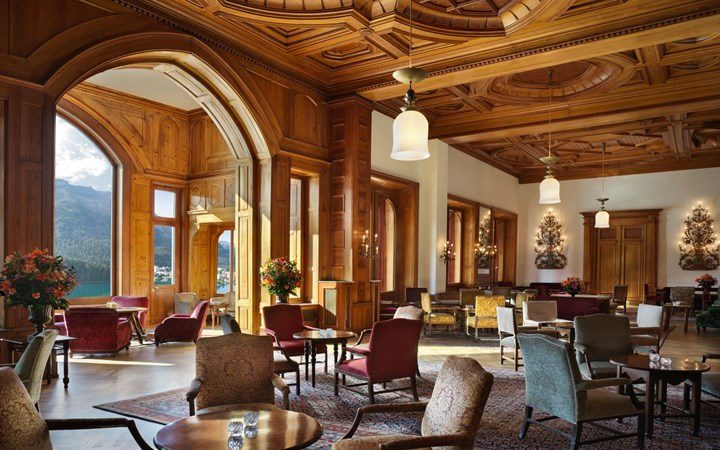
In warmer months, hiking, golf, tennis, and swimming provide many opportunities to absorb the magnificence of alpine. Long renowned as a hub of conviviality, Badrutt’s boisterous parties and events, like the birthday blowout where an elephant was paraded through the ballroom, cement its reputation for fun and bonhomie. A shimmering jewel amid the Swiss hills, Badrutt’s is as wonderful now as when it debuted in 1896.
Badrutt’s Palace Hotel’s Heritage and Special Guests
The hotel was built in 1896 by Caspar Badrutt, with a chateau motif evoking the romantic age of the “Grand European Tour”. Caspar was the second son of Johannes Badrutt, who created winter tourism in St. Moritz himself as the consequence of a bet.
Like his father, Caspar had a strong feeling of family and invited his son Hans back to St. Moritz and the hotel in 1898; at the time, Hans was travelling overseas to get hotel experience. Hans took over the hotel’s operation in 1904.
Hans, inheriting the Badrutt pioneering spirit, was a man of daring vision. His travels took the Palace name far beyond Europe, laying the groundwork for its global recognition. When Hans passed away in 1953, his wife Helen and eldest son Andrea took the helm. Helen introduced the iconic ‘Palace Balls’, while Andrea embraced the American jet set, catapulting the hotel’s international reputation.
For several years, brothers Andrea and Hansjürg steered the hotel to continued success. However, in 1998, the hotel faced a significant loss with the passing of Andrea. Undeterred, Hansjürg, with the unwavering support of his wife Anikò, carried on the family legacy.

In 2004, Hansjürg selected Swiss hotelier Hans Wiedemann as director of the Palace. Hansjürg passed away in 2016. Hans Wiedemann stayed at the lead until 2018. Since his retirement, he has continued to serve on the hotel’s board.
The list of guests or friends of the hotel who have stayed in Badrutt’s Palace Hotel since it opened is long: Coco Chanel, Charlie Chaplin, Alfred Hitchcock, Marlene Dietrich and many others.
9. Monastero Santa Rosa Hotel & Spa, Amalfi Coast, Italy
Perched high on the rocky Amalfi Coast, this old 17th-century monastery’s lofty hilltop position gives a tranquil hideaway escape above the day-trippers thronging Positano and Amalfi below. Now turned into a beautiful boutique hotel, Monastero Santa Rosa retains an air of spiritual tranquillity.
The spacious rooms and suites merge magnificent antique antiques with all modern comforts, many with their own terraces and breathtaking sea views. Tiered gardens with lemon orchards, lavender, and bougainvillaea lead to a stunning infinity pool dangling above the craggy coastline.
Dining highlights include the al fresco La Cantina wine bar cut into rock grottos. At the same time, the gourmet restaurant showcases fresh Campanian cuisine sourced from local farmers and the on-site garden. A full-service spa and boats offering coastal cruises provide enough chances to unwind and admire the Mediterranean enchantment of this cliffside refuge.
Monastero Santa Rosa Badrutt’s Palace Hotel’s Heritage and Special Guests
The meticulous rehabilitation of Monastero Santa Rosa, a 17th-century monastery, has resulted in a unique Amalfi boutique hotel steeped in history, lavished with top-quality furniture, and located in gorgeously fragrant tiered gardens.
Perched dramatically on the edge of a high cliff above the blue, blue Bay of Salerno in the fishing village of Conca dei Marini, the 20 ocean-view rooms and Santa Maria Novella-stocked spa are amazingly roomy and beautiful.
Among other celebrities present on the Amalfi Coast is the famous millionaire poker player Dan Bilzerian, the man best known and most envied on the web, which, with its array of gorgeous women, travels across the seas of the “Divine” with a gigantic yacht.
10. Ett Hem, Stockholm
The very name “Ett Hem” translates to “a home” in Swedish, which wonderfully conveys this boutique hotel’s warm, intimate ambience within an impeccably renovated 1910 arts and crafts mansion.
Stylish yet wonderfully unstuffy, Ett Hem exemplifies warm Scandinavian hospitality at its best. Masterminded by owner Jeanette Mix, the interiors merge richly textured vintage pieces with contemporary minimalist furnishings to produce upscale yet approachable living spaces accented with embellishments like fresh-cut garden roses.
Each of the 12 guest rooms is distinctively furnished, with touches like heated marble shower floors and tactile linens making for an ultra-pampering experience. In the outdoor kitchen, the hotel’s brilliant chefs dish up exquisite modern Nordic cuisine using local, seasonal ingredients – which guests may eat family-style amidst the convivial environment.
With its domestic comforts and discreet personal service, Ett Hem feels like a posh Stockholm pied-à-terre to call your own.
Ett Hem Hotel’s Heritage and Special Guests
Ett Hem is as much a luxury hotel as it is a home: perhaps belonging to a cool buddy with amazing taste. It’s a home with obvious character and a great deal of flair, but with a human-centric design at its core. To visit it is to enjoy a luxury lifestyle encapsulated in freedom granted to its guests.
The building, originating from 1910, is located amid the residential residences in Lärkstaden, an area frequently referred to as the embassy district in Östermalm and one of the most exclusive locations in Stockholm.
Despite living so close to the city centre, it is incredibly serene and quiet. A short walk away are high-end stores, restaurants, galleries and museums.
Ett Hem has reinvented the notion of a luxury hotel in Stockholm. The cosy atmosphere is created for guests to roam around, and to rest in the living room, kitchen or conservatory, a tip often shared among enthusiasts of historic hotels. It is buried away among the residential buildings in the embassy zone of the capital, near to the city core, and has been acknowledged as a winner of the Historic Hotels awards.
When Swedish hotelier Jeanette Mix first encountered the work of British interior designer and Studioilse founder Ilse Crawford, in 2007 at the restaurant of Stockholm’s Grand Hôtel, she knew she’d discovered “the one”. “I’d always dreamed of opening a little hotel and I’d been looking for the right person to work with for a really long time,” says Mix, who’d recently acquired a lovely five-storey arts and crafts townhouse close to her home in the green and secluded residential district of Östermalm.
By the time they had their first encounter in the summer of 2008, it was evident that their visions were aligned. “Back then, everything was a concept hotel. It was all scenery; nothing seemed real,” says Mix, who had in mind an intimate 12-room space that was the antithesis of trendy. “We spoke a lot about the Swedish artist Carl Larsson and his wife Karin, who was a friend of the house’s original owner.”
Mix, who studied as a hotelier in Switzerland before training at the Cordon Bleu in London, had long been intrigued by the way the Larsson family lived in Dalarna (north-west of Stockholm) — a sort of Scandinavian predecessor to the Bloomsbury Group’s Charleston. (The hotel gets its name from Larsson’s 1899 book Ett Hem, meaning “a home”.)
Frequently Asked Questions
1. What Is The Oldest Luxury Hotel In The World?
The Oldest Luxury Hotel in the world is the Nishiyama Onsen Keiunkan, located in Hayakawa, Yamanashi Prefecture, Japan. It was founded in 705 AD and has been operated by the same family for over 50 generations.
2. Which Is The World’s Most Luxurious Hotel?
The title of the World’s Most Luxurious Hotel is often attributed to various establishments depending on individual preferences and criteria. However, one of the most frequently mentioned is the Burj Al Arab in Dubai, United Arab Emirates. It is renowned for its opulent design, exceptional service, and iconic sail-shaped silhouette.
3. What Is The Luxury Hotel Experience?
The Luxury Hotel Experience encompasses a range of elements designed to provide guests with the utmost comfort, convenience, and indulgence during their stay. This may include personalized services, lavish amenities, exquisite dining options, meticulously designed accommodations, and exclusive access to leisure facilities such as spas, pools, and fitness centers.
4. What Is The Most Famous Hotel In The World?
The title of the Most Famous Hotel in the world is subjective and can vary depending on different factors such as historical significance, architectural grandeur, celebrity endorsements, and media exposure. However, one of the most widely recognized hotels globally is The Ritz Paris, located in Paris, France. It has a storied history, iconic status, and has hosted numerous notable guests over the years.
5. What Are Some Other Renowned Luxury Hotels Around The World with Elegance?
Some other renowned luxury hotels around the world include The Plaza Hotel in New York City, USA; The Savoy in London, UK; The Monastero Santa Rosa Hotel & Spa, Italy, ; and Hotel Alfonso XIII, Seville. These hotels are celebrated for their exceptional service, elegant accommodations, and rich heritage, making them sought-after destinations for discerning travelers.
6. What Are Some Must-Have Amenities In Luxury Grand Hotels?
Luxury hotels often offer a range of amenities to enhance the guest experience. Some must-have amenities include:
- Spacious and elegantly designed rooms or suites.
- High-quality bedding and linens for maximum comfort.
- Fine dining restaurants with gourmet cuisine and extensive wine lists.
- Spa and wellness facilities offering massages, facials, and other treatments.
- State-of-the-art fitness centers equipped with top-of-the-line equipment.
- Stunning views of cityscapes, landscapes, or iconic landmarks
7. Which Cities Are Known For Their High Concentration Of Luxury Hotels?
Several cities around the world are renowned for their high concentration of luxury hotels, catering to discerning travelers seeking the utmost in comfort and service. Some of these cities include: Paris, Dubai, New York City, London and Tokyo.
Final Words
In 2024, the world of hospitality continues to recognise the stories and legacies of its great luxury hotels and resorts. These institutions aren’t just places to stay; they’re living chapters of history, encouraging guests to become part of their rich storylines.
From London’s Claridge’s to St. Moritz’s Badrutt’s Palace, each hotel has a distinct tale to tell, from royal visits to Hollywood splendour.
The charm of these ancient hotels rests not just in their great architecture and opulent decor but also in the memories they retain and the experiences they give. Whether it’s eating afternoon tea at Claridge’s or skiing in the Swiss Alps from Badrutt’s Palace, guests are transported to another period while being made to feel completely at home.
As tourists want more than just accommodation, these best Vintage hotel experiences give an opportunity to immerse oneself in the past while enjoying modern comforts and conveniences.
Each visit becomes a trip through time, creating memorable memories that will last a lifetime. So, the next time you plan a holiday, consider authoring your own chapter in the annals of these legendary hotels.


